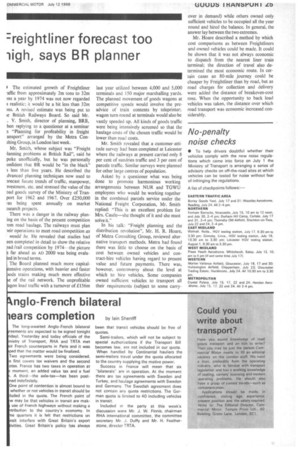:reightliner forecast too
Page 27

If you've noticed an error in this article please click here to report it so we can fix it.
ugh, says BR planner I The estimated growth of Freightliner -affic from approximately 2m tons to 32m ms a year by 1974 was not now regarded s realistic; it would be a bit less than 32m ms. A revised estimate was being put to ie British Railways Board. So said Mr. .. V. Smith, director of planning, BRB, hen replying to a questioner at a seminar a "Planning for profitability in freight ansport" arranged by the Metra Conalting Group, in London last week.
Mr. Smith, whose subject was "Freight ilanning problems at British Rail", said he poke unofficially, but he was personally onfident that BR would be "in the black" .1 less than five years. He described the .dvanced planning techniques now used to Drecast future trends of traffic, manpower, westment, etc. and stressed the value of the cad goods survey of the Ministry of Tranport for 1962 and 1967. Over £250,000 'as being spent annually on market esearch projects.
There was a danger in the railway planing an the basis of the present competition -om road haulage. The railways must plan ieir operations to meet road competition as ' would he. He revealed that studies had pen completed in detail to show the relative ad/rail competition by 1974---the picture far ahead as AD 2000 was being evalu
d in broad terms.
The Board planned much more capitaltensive operations, with heavier and faster ads trains making much more effective e of the rail network. The unprofitable agon load traffic with a turnover of £156m last year utilized between 4,000 and 5,000 terminals and 150 major marshalling yards. The planned movement of goods wagons at competitive speeds would involve the preadvice of train contents by teleprinter; wagon turn-round at terminals would also be vastly speeded up. All kinds of goods traffic were being intensively screened so that the haulage costs of the chosen traffic would be lower than road costs.
Mr. Smith revealed that a customer-attitude survey had been completed at Leicester where the railways at present carried only 8 per cent of sundries traffic and 3 per cent of parcels traffic. Similar surveys were planned for other large centres of population.
Asked by a questioner what was being done to promote harmonious working arrangements between NUR and TGWU employees who would be working together in the combined parcels service under the National Freight Corporation, Mr. Smith replied: "This is an excellent problem for Mrs. Castle—she thought of it and she must solve it."
In his talk: "Freight planning and the distribution revolution", Mr. H. R. Hoare, of Metra Consulting Group, reviewed alternative transport methods. Metra had found there was little to choose on the basis of cost between owned vehicles and contract-hire vehicles having regard to present value and future payments. There was, however, controversy about the level at which to hire vehicles. Some companies owned sufficient vehicles to transport all their requirements (subject to some carry
over in demand) while others owned only sufficient vehicles to be occupied all the year round and hired the balance. In general, the answer lay between the two extremes.
Mr. Hoare described a method by which cost comparisons as between Freightliners and owned vehicles could be made. It could be shown that it was not always economic to dispatch from the nearest liner train terminal; the direction of travel also determined the most economic route. In certain cases an 80-mile journey could be cheaper by Freightliner than by road, but as road charges for collection and delivery were added the distance of breakeven-cost rose. When the opportunity to back load vehicles was taken, the distance over which road transport was economic increased considerably.












































































































